Related Research Articles
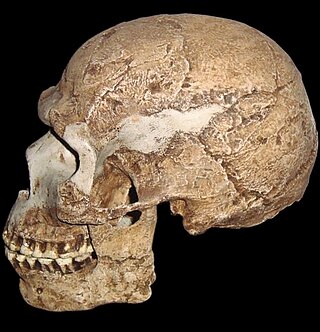
Early modern human (EMH), or anatomically modern human (AMH), are terms used to distinguish Homo sapiens that are anatomically consistent with the range of phenotypes seen in contemporary humans, from extinct archaic human species. This distinction is useful especially for times and regions where anatomically modern and archaic humans co-existed, for example, in Paleolithic Europe. Among the oldest known remains of Homo sapiens are those found at the Omo-Kibish I archaeological site in south-western Ethiopia, dating to about 233,000 to 196,000 years ago, the Florisbad site in South Africa, dating to about 259,000 years ago, and the Jebel Irhoud site in Morocco, dated about 315,000 years ago.
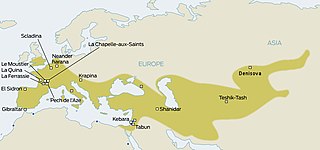
Neanderthals became extinct around 40,000 years ago. Hypotheses on the causes of the extinction include violence, transmission of diseases from modern humans which Neanderthals had no immunity to, competitive replacement, extinction by interbreeding with early modern human populations, natural catastrophes, climate change and inbreeding depression. It is likely that multiple factors caused the demise of an already low population.
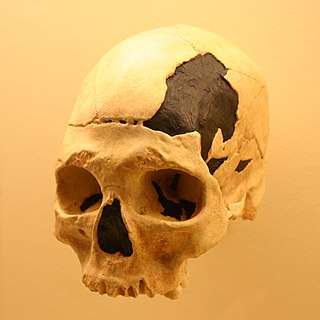
Peștera cu Oase is a system of 12 karstic galleries and chambers located near the city Anina, in the Caraș-Severin county, southwestern Romania, where some of the oldest European early modern human (EEMH) remains, between 42,000 and 37,000 years old, have been found.
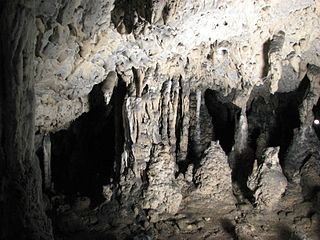
Peștera Muierilor, or Peștera Muierii, is an elaborate cave system located in the Baia de Fier commune, Gorj County, Romania. It contains abundant cave bear remains, as well as a human skull. The skull is radiocarbon dated to 30,150 ± 800, indication an absolute age between 40,000 and 30,000 BP. It was uncovered in 1952. Alongside similar remains found in Cioclovina Cave, they are among the most ancient early modern humans in Romanian prehistory.

Jean-Jacques Hublin is a French paleoanthropologist. He is a professor at the Max Planck Society, Leiden University and the University of Leipzig and the founder and director of the Department of Human Evolution at the Max Planck Institute for Evolutionary Anthropology in Leipzig, Germany. He is best known for his work on the Pleistocene hominins, and on the Neandertals and early Homo sapiens, in particular.

Vindija Cave is an archaeological site associated with Neanderthals and modern humans, located in the municipality of Donja Voća, northern Croatia. Remains of three Neanderthals were selected as the primary sources for the first draft sequence of the Neanderthal genome project in 2010. Additional research was done on the samples and published in 2017.
The multiregional hypothesis, multiregional evolution (MRE), or polycentric hypothesis, is a scientific model that provides an alternative explanation to the more widely accepted "Out of Africa" model of monogenesis for the pattern of human evolution.

Neanderthals are an extinct group of archaic humans who lived in Eurasia until about 40,000 years ago. The type specimen, Neanderthal 1, was found in 1856 in the Neander Valley in present-day Germany.

Neanderthal anatomy differed from modern humans in that they had a more robust build and distinctive morphological features, especially on the cranium, which gradually accumulated more derived aspects, particularly in certain isolated geographic regions. This robust build was an effective adaptation for Neanderthals, as they lived in the cold environments of Europe. In which they also had to operate in Europe's dense forest landscape that was extremely different from the environments of the African grassland plains that Homo sapiens adapted to with a different anatomical build.

Almost everything about Neanderthal behaviour remains controversial. From their physiology, Neanderthals are presumed to have been omnivores, but animal protein formed the majority of their dietary protein, showing them to have been carnivorous apex predators and not scavengers. Although very little is known of their social organization, it appears patrilines would make up the nucleus of the tribe, and women would seek out partners in neighbouring tribes once reaching adolescence, presumably to avoid inbreeding. An analysis based on finger-length ratios suggests that Neanderthals were more sexually competitive and promiscuous than modern-day humans.
Hominid dispersals in Europe refers to the colonisation of the European continent by various species of hominid, including hominins and archaic and modern humans.

Interbreeding between archaic and modern humans occurred during the Middle Paleolithic and early Upper Paleolithic. The interbreeding happened in several independent events that included Neanderthals and Denisovans, as well as several unidentified hominins.
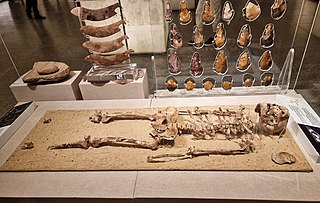
Nazlet Khater is an archeological site located in Upper Egypt that has yielded evidence of early human culture and anatomically modern specimens dating to approximately thirty to fifty thousand years ago.

Chancelade man is an ancient anatomically modern human fossil of a male found in Chancelade in France in 1888. The skeleton was that of a rather short man, who stood a mere 1.55 m (5.1 ft) tall.
Zhiren Cave is a karstic cave in the Mulan Mountains that overlooks the Hejiang River in Chongzuo, Guangxi, China. Zhiren Cave is an early Late Pleistocene site that has yielded the fossil remains of possibly anatomically modern humans with some mixed archaic human features.

Southwest Asian Neanderthals were Neanderthals who lived in Turkey, Lebanon, Syria, Israel, Palestine, Iraq, and Iran - the southernmost expanse of the known Neanderthal range. Although their arrival in Asia is not well-dated, early Neanderthals occupied the region apparently until about 100,000 years ago. At this time, Homo sapiens immigrants seem to have replaced them in one of the first anatomically-modern expansions out of Africa. In their turn, starting around 80,000 years ago, Neanderthals seem to have returned and replaced Homo sapiens in Southwest Asia. They inhabited the region until about 55,000 years ago.

Krapina Neanderthal site, also known as Hušnjakovo Hill is a Paleolithic archaeological site located near Krapina, Croatia.

Sima de las Palomas is on Cabezo Gordo, located between Balsicas and San Javier in the Murcia region of Spain. It was inhabited for tens of thousands of years, by Neanderthals and others. The shaft was filled in with brecciated material in the Late Pleistocene, and was partly excavated by miners in the nineteenth century. In the rubble, fossil remains of humans, including those of Neanderthals, were found in the 1990s, and after excavations in the shaft, in 2006-2007 a skeleton of a young Neanderthal woman was found, possibly buried with her child.
The Hualongdong people are extinct humans that lived in eastern China around 300,000 years ago during the late Middle Pleistocene. Discovered by a research team led by Xiujie Wu and Liu Wu, of the Chinese Academy of Sciences, from the Hualong Cave in Dongzhi County at Anhui Province in 2006, they are known from about 30 fossils that belong to 16 individuals. The first analysis of the skull fragments collected in 2006 suggested that they could be members of Homo erectus. For some of the specimens, their exact position as a human species is not known. More complete fossils found in 2015 indicate that they cannot be directly assigned to any Homo species as they also exhibit archaic human features. They are the first humans in Asia to have both archaic and modern human features. They are likely a distinct species that form a separate branch in the human family tree.
References
- ↑ Washington University (4 May 2017). "Faculty Page for Erik Trinkaus". Washington University in St Louis. Washington University. Retrieved 12 March 2024.
- ↑ Trinkaus, Erik. "Erik Trinkaus". Washington University. Archived from the original on 21 July 2013. Retrieved 20 March 2013.
- ↑ Trinkaus, Erik (2007). "European early modern humans and the fate of the Neandertals". Proceedings of the National Academy of Sciences USA. 104 (18): 7367–7372. Bibcode:2007PNAS..104.7367T. doi: 10.1073/pnas.0702214104 . PMC 1863481 . PMID 17452632.
- ↑ Trinkaus, Erik (1981). Aspects of Human Evolution. London: Taylor & Francis. pp. 187–224.
- ↑ Trinkaus, Erik (1986). "The Neandertals and modern human origins". Annual Review of Anthropology. 15 (15): 193–218. doi:10.1146/annurev.an.15.100186.001205.
- ↑ Trinkaus, Erik (2013). Origins of Modern Humans: Biology Reconsidered (2nd ed.). John Wiley & Sons. pp. 393–434. doi:10.1002/9781118659991.ch12. ISBN 978-0-470-89409-5 . Retrieved 14 March 2024.
- ↑ Trinkaus, Erik (1983). The Shanidar Neandertals (1st ed.). New York: Academic Press. ISBN 978-0-12-700550-8 . Retrieved 12 March 2024.
- ↑ Duarte, Cidalia; João Maurício; Paul B. Pettitt; Pedro Souto; Erik Trinkaus; Hans van der Plicht; João Zilhão (June 22, 1999). "The early Upper Paleolithic human skeleton from the Abrigo do Lagar Velho (Portugal) and modern human emergence in Iberia". Proceedings of the National Academy of Sciences. 96 (13): 7604–7609. Bibcode:1999PNAS...96.7604D. doi: 10.1073/pnas.96.13.7604 . PMC 22133 . PMID 10377462.
- ↑ Trinkaus E, Svoboda, J. (2005). Early Modern Human Evolution in Central Europe: The People of Dolni Vestonice and Pavlov. Oxford University Press. ISBN 978-0-19-516699-6.
{{cite book}}: CS1 maint: multiple names: authors list (link) - ↑ Trinkaus, E., Moldovan, O., Milota, Ş., Bîlgăr, A., Sarcina, L., Athreya, S., Bailey, S.E., Rodrigo, R., Mircea, G., Higham, T. and Ramsey, C.B. (2003). "An early modern human from the Peştera cu Oase, Romania". Proceedings of the National Academy of Sciences. 100 (20): 11231–11236. Bibcode:2003PNAS..10011231T. doi: 10.1073/pnas.2035108100 . hdl: 1969.1/182639 . PMC 208740 . PMID 14504393.
{{cite journal}}: CS1 maint: multiple names: authors list (link) - ↑ Doboş, Adrian; Soficaru, Andrei; Trinkaus, Erik (2012). The prehistory and paleontology of the Peştera Muierii (Romania). Liege: Université de Liège, Service de Préhistoire. ISBN 9782930495095 . Retrieved 12 March 2024.
- ↑ Trinkaus, E., Smith, F.H., Stockton, T.C. & Shackelford, L.L. (2006). Early Modern Humans at the Moravian Gate: The Mladeč Caves and their Remains. Vienna: Springer Verlag. pp. 385–445. doi:10.1007/978-3-211-49294-9_13. ISBN 978-3-211-23588-1 . Retrieved 14 March 2024.
{{cite book}}: CS1 maint: multiple names: authors list (link) - ↑ Shang, H., Trinkaus, E. (2010). The Early Modern Human from Tianyuan Cave, China. College Station: Texas A&M University Press. p. 245. ISBN 978-1-60344-177-3 . Retrieved 14 March 2024.
{{cite book}}: CS1 maint: multiple names: authors list (link) - ↑ Trinkaus, E., Buzhilova, A.P., Mednikova, M.B., Dobrovolskaya, M.V. (2014). The People of Sunghir: Burials, Bodies and Behavior in the Earlier Upper Paleolithic. New York: Oxford University Press. p. 339. ISBN 978-0-19-938105-0 . Retrieved 14 March 2024.
{{cite book}}: CS1 maint: multiple names: authors list (link) - ↑ Trinkaus, Erik (2016). The Krapina Human Postcranial Remains. Morphology, Morphometrics and Paleopathology (PDF). Zagreb: FF Press. p. 152. ISBN 978-953-175-591-7 . Retrieved 14 March 2024.
- ↑ Willman, J.C., Maki, J., Bayle, P., Trinkaus, E., Zilhão, J (2012). "Middle Paleolithic human remains from the Gruta da Oliveira (Torres Nova), Portugal". American Journal of Physical Anthropology. 149 (1): 39–51. doi:10.1002/ajpa.22091. PMID 22610966 . Retrieved 14 March 2024.
{{cite journal}}: CS1 maint: multiple names: authors list (link) - ↑ Trinkaus, E., Mednikova, M.B., Cowgill, L.W. (2016). "The appendicular remains of the Kiik-Koba 2 Neandertal infant". PaleoAnthropology: 185–210. doi:10.4207/PA.2016.art103 (inactive 2024-03-14). Retrieved 14 March 2024.
{{cite journal}}: CS1 maint: DOI inactive as of March 2024 (link) CS1 maint: multiple names: authors list (link) - ↑ Trinkaus, E., Walker, M.J. (2017). The People of Palomas: The Neandertals from the Sima de las Palomas del Cabezo Gordo, Southeastern Spain. College Station: Texas A&M University Press. p. 278. ISBN 978-1-62349-479-7 . Retrieved 14 March 2024.
{{cite book}}: CS1 maint: multiple names: authors list (link) - ↑ Lebel, S. & Trinkaus, E (2002). "Middle Pleistocene human remains from the Bau de l'Aubesier". Journal of Human Evolution. 43 (5): 659–685. doi:10.1006/jhev.2002.0598. PMID 12457854 . Retrieved 14 March 2024.
{{cite journal}}: CS1 maint: multiple names: authors list (link) - ↑ Trinkaus, Erik (2009). "The human tibia from Broken Hill, Kabwe, Zambia". PaleoAnthropology: 145–165. ISSN 1545-0031 . Retrieved 2024-03-14.
- ↑ Wu, X.J., Pei, S.W., Cai, Y.J., Tong, H.W., Li, Q., Dong, Z., Sheng, J.C., Jin, Z.T., Ma, D.D., Xing, S., Li, X.L., Cheng, X., Cheng, H., de la Torre, I., Edwards, R.L., Gong, X.C., An, Z.S., Trinkaus, E., Liu, W. (2019). "Archaic human remains from Hualongdong, China, and Middle Pleistocene human continuity and variation". Proceedings of National Academy of Sciences USA. 116 (20): 9820–9824. Bibcode:2019PNAS..116.9820W. doi: 10.1073/pnas.1902396116 . PMC 6525539 . PMID 31036653.
{{cite journal}}: CS1 maint: multiple names: authors list (link) - ↑ Trinkaus, E., Wu, X.J. (2017). "External auditory exostoses in the Xuchang and Xujiayao human remains: Patterns and implications among eastern Eurasian Middle and Late Pleistocene crania". PLOS One. 12 (12): e0189390. Bibcode:2017PLoSO..1289390T. doi: 10.1371/journal.pone.0189390 . PMC 5726651 . PMID 29232394.
{{cite journal}}: CS1 maint: multiple names: authors list (link) - ↑ Li, Z.Y., Wu, X.J., Zhou, L.P., Liu, W., Gao, X., Nian, X.M., Trinkaus, E (2017). "Late Pleistocene archaic human crania from Xuchang, China". Science. 355 (6328): 969–972. Bibcode:2017Sci...355..969L. doi:10.1126/science.aal2482. PMID 28254945 . Retrieved 18 March 2024.
{{cite journal}}: CS1 maint: multiple names: authors list (link) - ↑ Trinkaus, E., Sázelová, S., Svoboda, J. (2019). "Pieces of people in the Pavlovian: Burials, body parts and bones in the earlier Upper Palaeolithic". Human Remains and Violence. 50 (1): 70–87. doi: 10.7227/HRV.5.1.6 . Retrieved 14 March 2024.
{{cite journal}}: CS1 maint: multiple names: authors list (link) - ↑ Trinkaus, E., Buzhilova, A.P. (2018). "Diversity and differential disposal of the dead at Sunghir". Antiquity. 92 (361): 7–21. doi:10.15184/aqy.2017.223 . Retrieved 14 March 2024.
{{cite journal}}: CS1 maint: multiple names: authors list (link) - ↑ Wu, X.J., Schepartz L.A., Liu, W., Trinkaus, E. (2011). "Antemortem trauma and survival in the Late Middle Pleistocene human cranium from Maba, south China". Proceedings of the National Academy of Sciences USA. 108 (49): 19558–19562. Bibcode:2011PNAS..10819558W. doi: 10.1073/pnas.1117113108 . PMC 3241811 . PMID 22106311.
{{cite journal}}: CS1 maint: multiple names: authors list (link) - ↑ Trinkaus, Erik (2018). "An abundance of developmental anomalies and abnormalities in Pleistocene people". Proceedings of the National Academy of Sciences. 115 (47): 11941–11946. Bibcode:2018PNAS..11511941T. doi: 10.1073/pnas.1814989115 . PMC 6255161 . PMID 30397116.